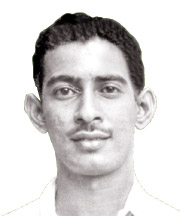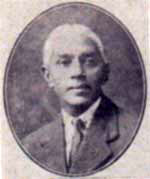An England team toured Australia between November 1920 and March 1921. The tour was organised by the Marylebone Cricket Club and matches outside the Tests were played under the MCC name. The tour itinerary consisted of 13 first-class matches, including a series of 5 Test matches against Australia in which The Ashes were at stake.
Marylebone Cricket Club organised the England cricket team's tour of Australia in the 1924–25 season. Australia won the Ashes series 4–1.
The England cricket team toured Australia in the 1936–37 season to play a five-match Test series against Australia for The Ashes. The tour was organised by the Marylebone Cricket Club and matches outside the Tests were played under the MCC name.
Cricket was introduced to Sri Lanka in the first quarter of the 19th century, following colonisation of the island by the British. The earliest known match was recorded in 1832 and the earliest first-class one in 1926. The national team has played Test cricket from 1982. The national team has achieved international success by winning the 1996 Cricket World Cup and the 2014 ICC World Twenty20. Cricket is played nationwide with Test venues in Colombo, Galle, Kandy and Moratuwa. The country's most notable players include Aravinda de Silva, Arjuna Ranatunga, Rangana Herath, Sanath Jayasuriya, Mahela Jayawardene, Muttiah Muralitharan, Kumar Sangakkara and Chaminda Vaas. Administration and governance are performed by Sri Lanka Cricket, which was founded in July 1922 as the Ceylon Cricket Association (CCA). The main domestic competition is the Premier Trophy which attained first-class status in 1988.

In the 1889–90 cricket season, an English team managed by George Vernon and captained by Lord Hawke toured Ceylon and India. It was a pioneering tour being the first visit by an English team to India and the second to Ceylon, following the stopover by Ivo Bligh's team to Australia in 1882–83. Vernon's team, known as G. F. Vernon's XI, was entirely composed of players with amateur status and, in the absence of professionals, none of its matches have been recognised as first-class. In all, they played thirteen matches from 28 November 1889 to 1 March 1890, starting with two games in Ceylon before moving on to Calcutta where the Indian part of the tour began in late December.
The Pakistan national cricket team toured Australia in the 1972–73 season and played three Test matches against the Australian national cricket team. After an inadequate preparation against weak teams, Pakistan lost by an innings in the first Test in Adelaide. While Australia won the series 3–0, the last two tests were competitive, with Pakistan seeming the likely winner on the second last days. The 2nd test in Melbourne was attended by 115,721. Pakistan also visited Sri Lanka and played a match against the Sri Lankan national cricket team and followed the tour with a series against New Zealand, where both teams played their first ODI.

A cricket team representing England toured Australia in the 1932–33 season. The tour was organised by the Marylebone Cricket Club and matches outside the Tests were played under the MCC name. The tour included five Test matches in Australia, and England won The Ashes by four games to one. The tour was highly controversial because of the bodyline bowling tactics used by the England team under the captaincy of Douglas Jardine. After the Australian tour was over, the MCC team moved on to play in New Zealand, where two further Test matches were played.

An English cricket team toured Australia and Ceylon in 1882–83. Captained by Ivo Bligh, the team was on a quest "to recover those Ashes", a reference to the famous RIP notice that was published in the aftermath of England's defeat by Australia at The Oval in the previous English season.
The England national cricket team toured Australia and Ceylon in 1891–92.

The England cricket team toured Australia and Ceylon in 1894–95. The team, captained by Andrew Stoddart, played 24 matches in total, of which it won 10, drew 10 and lost 4. In first-class cricket, the team played 12, won 8 and lost 4.

An English cricket team toured Australia in 1911–12. It was led by Plum Warner, but Johnny Douglas took over the captaincy for all five Test matches when Warner fell ill early in the tour. Despite losing the first Test at Sydney, a side which included Jack Hobbs, Frank Woolley, Sydney Barnes and Wilfred Rhodes hit back to win the remaining four Tests. They thus regained The Ashes.
This article describes the history of cricket in Pakistan from 1947 to 1970.
William Territt Greswell was an English first-class cricketer who played for Somerset from 1908 to 1930. But his career as a tea-planter with the family company in Ceylon meant that he appeared in only 115 first-class matches for the county in that period, and was a regular player in only five seasons, dotted over almost 20 years.
The England national cricket team, organised by Marylebone Cricket Club (MCC), toured India, Pakistan and Ceylon from October 1961 to February 1962. They played five Test matches against the India national cricket team, with India winning two matches and the other three being drawn; and three Tests against the Pakistan national cricket team, with England winning the first match and the other two drawn. The itinerary was unusual in that England began in Pakistan with three matches, including the first Test at the Gaddafi Stadium in Lahore, and then went on an extensive five-Test tour of India before crossing into East Pakistan, where they played their second Test against Pakistan at the Bangabandhu National Stadium in Dhaka. For the third Test against Pakistan, they travelled to the National Stadium, Karachi before completing the tour in February with three games in Ceylon. Ceylon was not a Test-qualified team at that time and played a single first-class match against MCC in Colombo which was won by MCC.
The England national cricket team, organised by Marylebone Cricket Club (MCC), toured India, Pakistan and Sri Lanka from December 1972 to March 1973 and played a five-match Test series against the India national cricket team followed by three Tests against the Pakistan national cricket team. England were captained by Tony Lewis. The Sri Lanka national cricket team was not Test-qualified at that time and played a single first-class match against MCC in Colombo.
Edward Wilhelm Adolphus Buultjens was a Ceylonese cricketer who played first-class matches for Ceylon representative teams, the antecedents of the current Sri Lankan national side.

Mohamed Abdal Hassain "Abu" Fuard was a Sri Lankan cricketer who played first-class cricket for Ceylon from 1957 to 1970 and served for many years as a national cricket administrator.
Lionel Fernando is a former cricketer who played for Ceylon from 1964 to 1971.
Edward George Samuel Kelaart was a Ceylonese cricketer who played first-class cricket between 1926 and 1935. He was Ceylon's first international captain, leading the side in two matches against India in 1932-33.

Lieutenant Colonel Dr John Rajathurai Rockwood, VD was the leading administrator and patron of cricket in Ceylon from 1914 to 1935. He helped put the nation's cricket administration in the hands of the Ceylonese, and served as president of the Ceylon Cricket Association from its formation in 1922 until 1933. A doctor, he was also a commanding officer of the Ceylon Medical Corps.